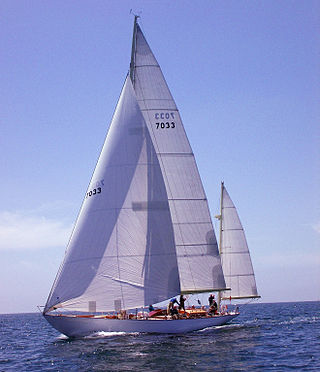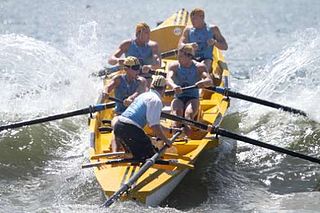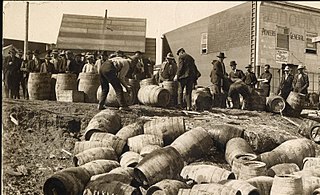
A dory is a small, shallow-draft boat, about 5 to 7 metres or 16 to 23 feet long. It is usually a lightweight boat with high sides, a flat bottom and sharp bows. It is easy to build because of its simple lines. For centuries, the dory has been used as a traditional fishing boat, both in coastal waters and in the open sea.

A dinghy is a type of small boat, often carried or towed by a larger vessel for use as a tender. Utility dinghies are usually rowboats or have an outboard motor. Some are rigged for sailing but they differ from sailing dinghies, which are designed first and foremost for sailing. A dinghy's main use is for transfers from larger boats, especially when the larger boat cannot dock at a suitably-sized port or marina.

A yawl is a type of boat. The term has several meanings. It can apply to the rig, to the hull type or to the use which the vessel is put.

A rudder is a primary control surface used to steer a ship, boat, submarine, hovercraft, airship, or other vehicle that moves through a fluid medium. On an airplane, the rudder is used primarily to counter adverse yaw and p-factor and is not the primary control used to turn the airplane. A rudder operates by redirecting the fluid past the hull or fuselage, thus imparting a turning or yawing motion to the craft. In basic form, a rudder is a flat plane or sheet of material attached with hinges to the craft's stern, tail, or after end. Often rudders are shaped so as to minimize hydrodynamic or aerodynamic drag. On simple watercraft, a tiller—essentially, a stick or pole acting as a lever arm—may be attached to the top of the rudder to allow it to be turned by a helmsman. In larger vessels, cables, pushrods, or hydraulics may be used to link rudders to steering wheels. In typical aircraft, the rudder is operated by pedals via mechanical linkages or hydraulics.
The Sea Bright Skiff is a box-skegged skiff developed on the northern shore of New Jersey. It was used for fishing, by being launched through the surf, sailed to the fishing grounds, and returned through the surf.

A surfboat is an oar-driven boat designed to enter the ocean from the beach in heavy surf or severe waves. It is often used in lifesaving or rescue missions where the most expedient access to victims is directly from the beach.

In watercraft, a racing shell is an extremely narrow, and often comparatively long, rowing boat specifically designed for racing or exercise. It is equipped with long oars, outriggers to hold the oarlocks away from the boat, and sliding seats. The boat's long length and semicircular cross-section reduce drag to a minimum. This makes the boat both fast and unstable. It must be balanced by the rowers to avoid tipping. Being able to balance – or "set" – the boat while putting maximum effort into the oars is therefore an essential skill of sport rowing.

Rum-running, or bootlegging, is the illegal business of smuggling alcoholic beverages where such transportation is forbidden by law. Smuggling usually takes place to circumvent taxation or prohibition laws within a particular jurisdiction. The term rum-running is more commonly applied to smuggling over water; bootlegging is applied to smuggling over land.

Coastal and offshore rowing is a rowing sport performed at sea. In North America, this sport is often called open water rowing.

The stern is the back or aft-most part of a ship or boat, technically defined as the area built up over the sternpost, extending upwards from the counter rail to the taffrail. The stern lies opposite the bow, the foremost part of a ship. Originally, the term only referred to the aft port section of the ship, but eventually came to refer to the entire back of a vessel. The stern end of a ship is indicated with a white navigation light at night.
Masula boat, also known as masulah boat, is a kind of non-rigid boat built without knees used on the coast of Madras, India, along with catamarans.

The pinas, sometimes called "pinis" as well, is a type of schooner of the east coast of the Malay peninsula, built in the Terengganu area. This kind of vessel was built of Chengal wood by the Malays since the 19th century and roamed the South China Sea and adjacent oceans as one of the two types of traditional sailing vessels the late Malay maritime culture has developed: The bedar and the pinas.

The term bedar is applied to a wide variety of boats of the east coast of Malaysia that carry one or two junk sails and lack the typical transom stern of the perahu pinas. These junk rigged boats are usually built in the Terengganu area. The stern of the bedar is a classical "canu" or "pinky stern," being a typical "double ender", a bit like a modern ship's lifeboat, with a very full turn of the bilge and with markedly raked stem and stern. They came in small versions as small one-masted fishing vessels — anak bedar and were built as big as 90 feet over deck (LOD). The majority of the bedars were usually 45 to 60 feet over deck. The bedar, like all Terengganu boats, was built of Chengal wood by the Malays since the 19th century and roamed the South China Sea and adjacent oceans as a highly seaworthy traditional sailing vessel.

Perahu Mayang or simply mayang is a type of fishing boat from Java, Indonesia. This type of boat is used mainly for fishing and trading. Historically, this indigenous vessel is also favored by European skippers and private merchants for trading in East Indies: 50% of them were using mayang and pencalang. It is mostly used in northern coast of Java. The major production site is in Rembang, Central Java.
The Dovekie 21, often called just the Dovekie, is an American sailing dinghy, named for the sea bird. It was designed by Phil Bolger as a cruiser and first built in 1978.
The Columbia 7.6 is an American/Canadian trailerable sailboat that was designed by Australian Alan Payne as a cruiser and first built in 1976.
This glossary of nautical terms is an alphabetical listing of terms and expressions connected with ships, shipping, seamanship and navigation on water. Some remain current, while many date from the 17th to 19th centuries. The word nautical derives from the Latin nauticus, from Greek nautikos, from nautēs: "sailor", from naus: "ship".
The Seafarer 23 is an American trailerable sailboat that was designed by McCurdy & Rhodes as a cruiser and first built in 1976.
The Columbia 8.7 is a sailboat that was designed by Alan Payne as a cruiser and first built in 1976.
The frejgatina is a traditional fishing boat from Malta, its name meaning "little frigate." It is a small, carvel-built rowing boat. It is generally only used to move from the shore to a larger boat anchored offshore.











